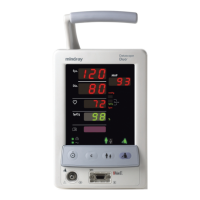Duo™ Operating Instructions 0070-10-0603-01 2 - 9
Operation Routine Operation
2.3.3 SpO
2
Measurement (Optional)
Each of the following terms are associated with blood oxygenation: oxygen saturation, pulse
oximetry, SpO
2
and plethysmography.
Oxygen saturation in capillary blood is measured by a method called pulse oximetry. Pulse
oximetry is a continuous and non-invasive measurement of the amount of oxygen attached to
the hemoglobin in red blood cells (also known as oxyhemoglobin saturation). SpO
2
is the
estimation of arterial oxygen saturation. This term is used interchangeably with SaO
2
. This
value is displayed in the SpO
2
parameter tile.
Traditional pulse oximetry determines SpO
2
by passing red and infrared light into a capillary
bed and measuring changes in light absorption during the pulsatile cycle. Red and infrared
light-emitting diodes (LEDs) in oximetry sensors serve as the light sources, a photodiode
serves as the photo detector.
Traditional pulse oximetry assumes that all pulsations in the light absorbance signal are
caused by oscillations in the arterial blood volume. This also assumes that the blood flow in
the region of the sensor passes entirely through the capillary bed rather than through any
arterio-venous shunts.
Performance Considerations
To ensure optimal SpO
2
measurement, use an appropriate sensor, apply it as directed, and
observe all warnings and cautions. Sensors are designed for specific sites on patients with
designated weight ranges. To select the appropriate sensor, consider the patient’s weight,
level of activity, adequacy of perfusion, available sensor sites and the sterility requirement.
If excessive ambient light is present, cover the sensor site with opaque material. Failure to do
so may cause inaccurate measurements. Light sources that can affect performance include
surgical lights (especially those with a xenon light source), bilirubin lamps, fluorescent lights,
infrared heating lamps, and direct sunlight.
In the event that a reading is unobtainable or inaccurate, consider the following:
• If the patient is poorly perfused, try applying the sensor to another site - such as a
different finger or toe.
• Ensure that the sensor is properly aligned and securely applied.
• Use a new sensor.
• Move the sensor to a less active site.
• Use a type of sensor that tolerates some patient motion.
• Ensure that the sensor and site are clean/non-greasy. Nail polish and
fungus should be removed.
Calibration
The oximetry sub-system incorporates automatic calibration mechanisms. No other
calibration is required.

